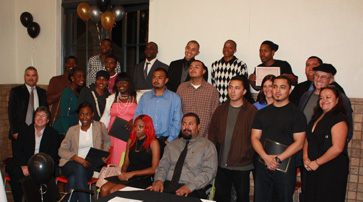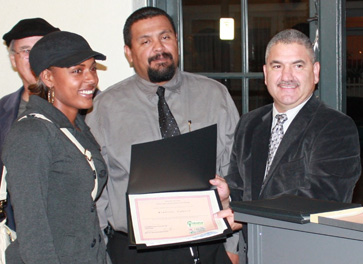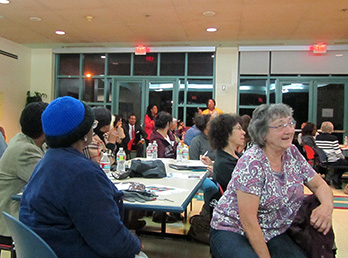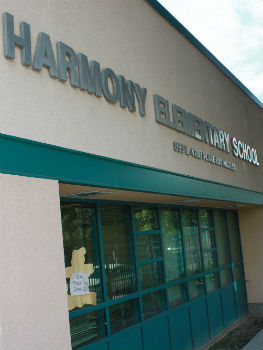By Steve Weingarten, People for Parks
 Graduates of a Dept. of Labor training program in South L.A. and Hollywood get ready for the working world
Graduates of a Dept. of Labor training program in South L.A. and Hollywood get ready for the working world
Parks mean different things to different people. Children make a beeline for the swings and slides, young adults choose sides for half-court basketball games, and families enjoy scarce green space for cookouts. When Nick Pedreira looks at a park, the Marine Corps veteran sees his future.
Pedreira and dozens of other Green Team members have learned to build and maintain urban parks in an 8-week program funded by the U.S. Department of Labor. Training was provided in classrooms, at a variety of public areas, and at Community-School Parks (CSPs) run by the L.A. Unified School District and People for Parks (PFP).
On Nov. 15, PFP and the Coalition for Responsible Community Development (CRCD) hosted a ceremony in South L.A. for Green Team graduates, who are now certified in skills applicable to private and public recreation facilities for creating and sustaining green spaces and maintaining recreational equipment.
CRCD Youth Development Director Noemi Soto told trainees that their graduation will unlock greater accomplishments, and said she was reminded of rapper Tupac Shakur’s verse, “I’m not saying I’m gonna change the world, but I guarantee that I will spark the brain that will change the world.”
PFP President Jack Foley recounted his own stormy youth as the son of a single mother in Northern California, including fights and getting expelled from high school before going on to earn a doctorate and teach at Cal State University Northridge. “Life is a long distance run. You can change. Connect with the people that can help you.”
Albert Areola described how proud he was to graduate. “I have messed up enough during my life. Now, at 20, I feel I have accomplished something. I thank CRCD for helping me to make my family happy.”
 Green Team member Kimberly Gafford receives her certification and diploma from CRCD’s Sal Ybarra (center) and Alex Martinez. Gafford developed new skills — and muscles — during more than 150 hours of classroom and hands-on training to create and maintain parks and recreation programs. Photo by Steve Weingarten Green Team member Kimberly Gafford receives her certification and diploma from CRCD’s Sal Ybarra (center) and Alex Martinez. Gafford developed new skills — and muscles — during more than 150 hours of classroom and hands-on training to create and maintain parks and recreation programs. Photo by Steve Weingarten |
Graduate Kimberly Gafford said she developed new skills – and muscles – in the program. “Landscaping is hard. You have to put your love into it. They had us filling wheelbarrows with soil and moving it across the street.”
Gafford is looking for a job now, but is concerned about being taken seriously in a field largely dominated by men. Meanwhile, she is working on the CRCD outreach team and studying speech. “I’m shy,” she said, “but I think that will help me communicate better.”
Joi Chilton was working for Jack in the Box before the training program. “The skills we learned are awesome. I like landscaping, and I love painting and finishing.” Chilton is now working for ADT alarm systems while she looks for work as a painter.
CSPs are landscaped playgrounds providing a healthier environment for students during the week and a safe spot for the whole neighborhood to enjoy during weekends and school breaks. Late last year, as PFP and the school district were putting the finishing touches on their first two CSPs, the Department of Labor agreed to pay at-risk youth while they learned to maintain the unconventional green spaces.
CRCD and another training partner, the Hollywood Beautification Team (HBT), recruited 18- to 24-year-olds from the neighborhoods around Trinity Street Elementary in South L.A. and Vine Street Elementary in Hollywood. Candidates had to pass a background check, but a high school diploma or GED weren’t required.
Trainees got their hands dirty learning the newest techniques in landscaping, pesticides and nutrition, including how to build bio-swales to prevent water from running off and redirecting it back into the water table. The 165-hour curriculum also included career strategies and life skills, such as handling a checking account and managing a budget.
For example, Florida-based Scott Burton, who educates experienced park professionals, gave a 3-hour training to the HBT Green Team on inspecting play equipment, including state and federal requirements for fall protection and other safety issues. Trainee Kathryn Loutzenagiser said Burton “taught us about all the dangers in a park for little kids, and all the things you can do to make parks safer.”
Miguel Cowo has worked with HBT since his senior year in high school, but hadn’t considered urban forestry as a calling until a landscape architect spoke to the class about how cities are going green. “All around us people are planting trees and creating parks, and it came into focus that this could be a great job for us.”
Angel de León said Green Team members are remaking neighborhoods “like you would want to live there. We are making a difference, whether it’s removing graffiti or planting trees. People thank us when we finish a job.”
Loutzenagiser, Cowo and De León all attended Vine Street Elementary as children. At the graduation ceremony, PFP’s Nancy Matthews told the trainees that the public-private partnership with the Labor Department is one way the government can help. “But you guys are the life of this program. You touched lives, communities and people, and have become role models for younger kids in the community.”
For more information about the Green Team program, contact Steve Weingarten of People for Parks at (626) 675-2156.
















 Civil rights activist Najee Ali is a familiar name to South LA. He is founder and Executive Director of Project Islamic H.O.P.E. (Helping Oppressed People Everywhere) and has been on the frontlines of many movements and issues in South LA. — everything from racism to police brutality to prostitution and more.
Civil rights activist Najee Ali is a familiar name to South LA. He is founder and Executive Director of Project Islamic H.O.P.E. (Helping Oppressed People Everywhere) and has been on the frontlines of many movements and issues in South LA. — everything from racism to police brutality to prostitution and more.


.jpg)





